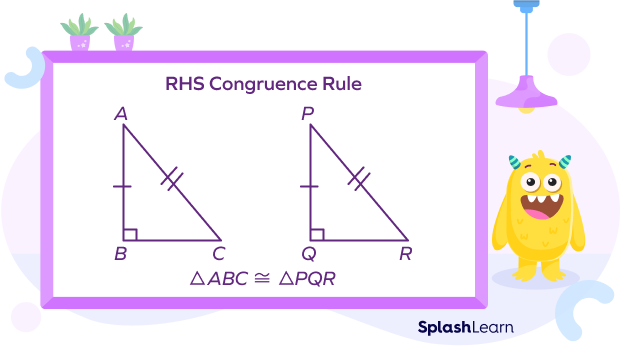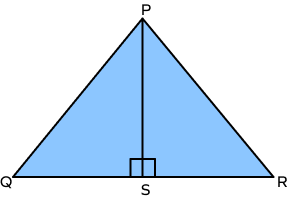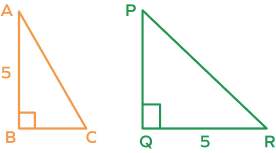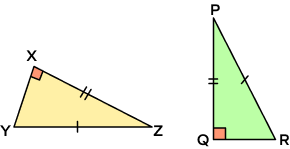What Is the RHS Congruence Rule in Geometry?
RHS (Right angle-Hypotenuse-Side) congruence criterion is used to prove the congruence of two right-angled triangles. It states that if the hypotenuse and one side (leg) of one right triangle are congruent to the hypotenuse and the corresponding side of the other right triangle, then the two right triangles are congruent.
In the diagram shown below, there are two right triangles ▵ABC & ▵PQR such that
hypotenuse AC = hypotenuse PR
Side AB = Side PQ
Thus, by RHS congruence criterion, ▵ABC ≅ ▵PQR

The RHS congruence rule is also known as the HL (Hypotenuse-Leg) congruence rule. Note that this theorem is only applicable to the right-angled triangles.
The RHS rule is based on the Pythagoras theorem. In a right triangle, if we know the length of any two sides, we can find the length of the missing side using the Pythagoras theorem, which states that
Hypotenuse2 = Base2 + Perpendicular2
Thus, if the hypotenuse and one side of one right triangle are congruent to the hypotenuse and corresponding side of another right triangle, the remaining sides will automatically be equal.
RHS Congruence Rule Statement
The RHS (Right Angle-Hypotenuse-Side) congruence rule states that if the hypotenuse and one side of one right triangle is equal to the hypotenuse and corresponding side of the other right triangle, then the two given right triangles are congruent.
Proof of RHS Congruence Theorem
Given: Two right-angled triangles ABC and DEF where ∠B=90° and ∠E=90°.
Hypotenuses are equal. (AC = DF)
One pair of corresponding sides is equal. (BC = EF)

To prove: ΔABC ≅ ΔDEF
Proof:
| Statement | Reason |
|---|---|
| $AC^{2} = AB^{2} + BC^{2}$ $\Rightarrow AB^{2} = AC^{2} – BC^{2}$ …(1) | Pythagoras theorem in right triangle ABC |
| $DF^{2} = DE^{2} + EF^{2}$ $\Rightarrow DE^{2} = DF^{2} – EF^{2}$ …(2) | Pythagoras theorem in right triangle DEF |
| AC = DF and BC = EF …(3) | Given |
| $AB^{2} = DF^{2} – EF^{2}$ …(4) | From (1) and (3) |
| $AB^{2} = DE^{2}$ $\Rightarrow AB = DE$ | From (2) and (4) |
| In ΔABC and ΔDEF, AB = DE BC = EF AC = DF | From (3) and (4) |
| ΔABC ≅ ΔDEF | SSS Congruence Criterion |
Conclusion
In this article, we learned about the Right Hand Side (RHS) Congruence Rule and how it is applied. By understanding this rule, we can determine the congruence of two right triangles based on the congruence of their hypotenuse and one corresponding leg. Let’s solidify our understanding by working through examples and practicing MCQs for better comprehension.
Facts about RHS Congruence Rule
- The RHS (Right-Hand-Side) Congruence Rule is also known as the Hypotenuse-Leg Congruence Rule or the HL Congruence Rule.
- The RHS congruence rule is only applicable to right triangles.
Solved Examples on RHS Congruence Theorem
Example 1: In the given figure PQ = PR, ∠PSQ=∠PSR=90°. Prove that ΔPSQ ≅ ΔPSR

Solution:
In ΔPSQ and ΔPSR,
PQ = PR (given)
PS = PS (common side)
∠QSP=∠RSP (both right angles)
Hypotenuse and one side of ΔPSQ is congruent to the hypotenuse and the corresponding side of ΔPSR.
Thus, by RHS rule, ΔPSQ ≅ ΔPSR. Hence proved.
Example 2: Are the two right triangles ΔABC and ΔPQR congruent by RHS rule?

Solution:
To prove that two right triangles ΔABC and ΔPQR are congruent by RHS congruence criterion, the hypotenuse and one side of ΔABC must be congruent to the hypotenuse and the corresponding side of ΔPQR.
Here, it is given that AB = QR and ∠ABC=∠PQR=90.
However, it is not mentioned that the hypotenuses are equal.
Thus, we cannot say that the two triangles are congruent by RHS congruence rule. The information is not sufficient.
Example 3: Prove the given triangles are congruent.

Solution:
In the given triangles, ΔYXZ and ΔPQR,
side XZ = side PQ (given)
Hypotenuse YZ = Hypotenuse PR (given)
∠YXZ=∠PQR =90° (given)
Hypotenuse and one side of ΔYXZ is congruent to the hypotenuse and the corresponding side of ΔPQR.
Thus, by RHS theorem, ΔYXZ ≅ ΔPQR.
Practice Problems on RHS Congruence Theorem
RHS Congruence Rule - Statement, Proof, Examples, Facts, FAQs
What does RHS stand for in the RHS congruence theorem?
The RHS theorem stands for Right side-Hypotenuse-Side theorem.
What information is necessary to prove that ΔPOQ ≅ ΔPOR by the RHS congruence rule?
In ΔPOQ and ΔPOR.
PO = PO (common side)
∠POQ = ∠POR = 90° (given)
For ΔPOQ & ΔPOR to be congruent by the RHS rule, the hypotenuses must be congruent.
We must have PQ = PR.
In the right triangle ΔABC, if AB is 4 units and BC is 3 units. Find the side AC.
$Hypotenuse^{2}$ = Base^{2} + Perpendicular^{2}$ (by Pythagoras theorem)
$AC^{2} = AB^{2} + BC^{2}$
$AC^{2} = 4^{2} + 3^{2}$
$AC^{2} = 16 + 9$
$AC^{2} = 25$
$AC = \sqrt{25}$
AC = 5 units
Frequently Asked Questions about RHS Congruence Theorem
When can we apply the RHS Congruence Rule?
The RHS Congruence Rule can be applied when we have to check if two right triangles are congruent, where we know the lengths of the hypotenuse and one side of the triangle.
Can we use the RHS Congruence Rule to prove congruence for non-right triangles?
No, the RHS Congruence Rule is applicable only to the right triangles.
Is the RHS Congruence rule and the HL congruence theorem same?
Yes, the RHS Congruence Rule and the HL (Hypotenuse-Leg) Congruence Theorem are the same.
















